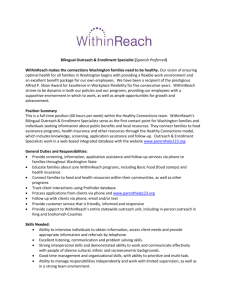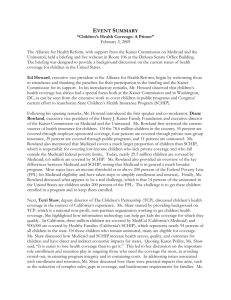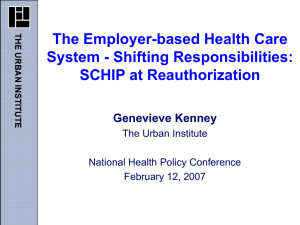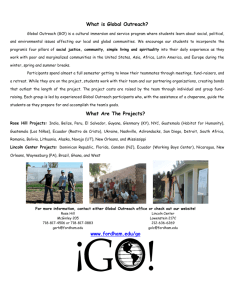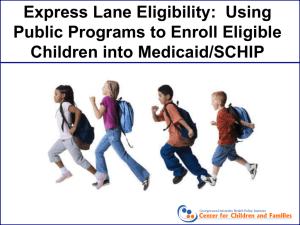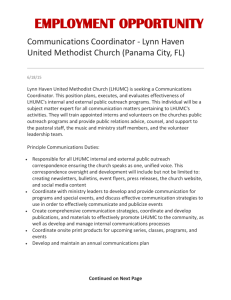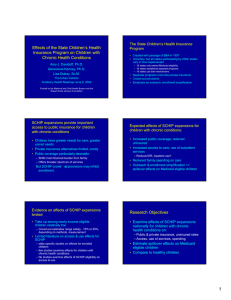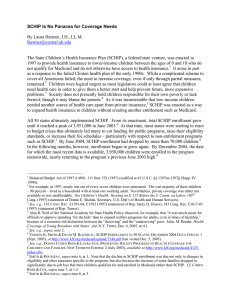Sample Phone Script - Covering Kids & Families
advertisement
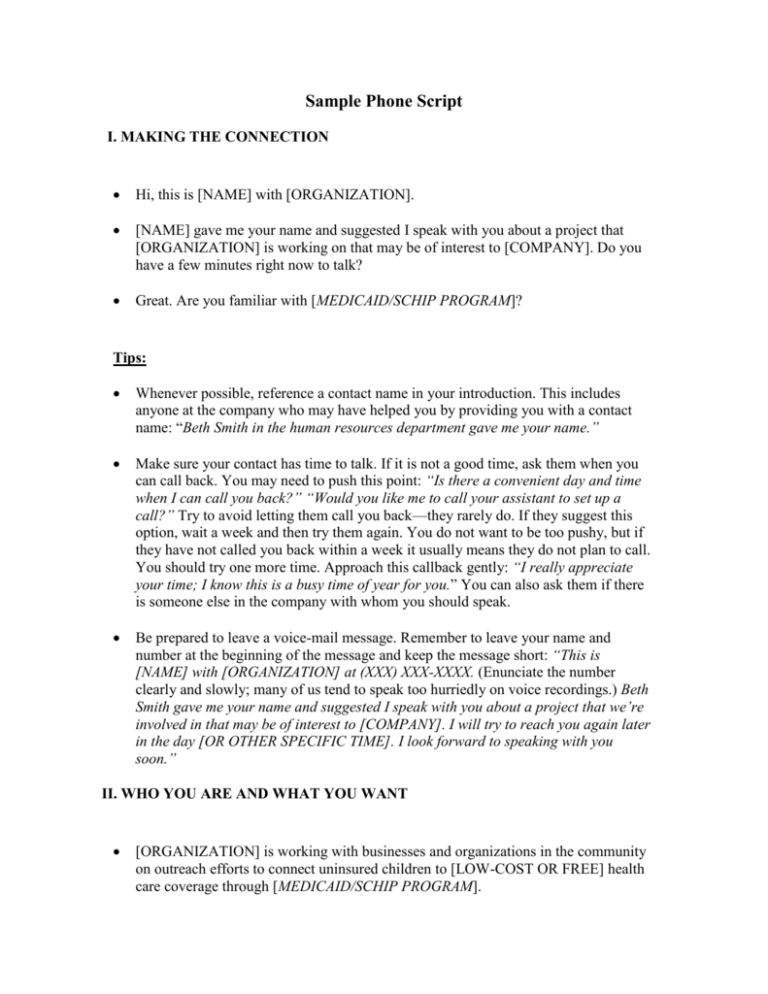
Sample Phone Script I. MAKING THE CONNECTION Hi, this is [NAME] with [ORGANIZATION]. [NAME] gave me your name and suggested I speak with you about a project that [ORGANIZATION] is working on that may be of interest to [COMPANY]. Do you have a few minutes right now to talk? Great. Are you familiar with [MEDICAID/SCHIP PROGRAM]? Tips: Whenever possible, reference a contact name in your introduction. This includes anyone at the company who may have helped you by providing you with a contact name: “Beth Smith in the human resources department gave me your name.” Make sure your contact has time to talk. If it is not a good time, ask them when you can call back. You may need to push this point: “Is there a convenient day and time when I can call you back?” “Would you like me to call your assistant to set up a call?” Try to avoid letting them call you back—they rarely do. If they suggest this option, wait a week and then try them again. You do not want to be too pushy, but if they have not called you back within a week it usually means they do not plan to call. You should try one more time. Approach this callback gently: “I really appreciate your time; I know this is a busy time of year for you.” You can also ask them if there is someone else in the company with whom you should speak. Be prepared to leave a voice-mail message. Remember to leave your name and number at the beginning of the message and keep the message short: “This is [NAME] with [ORGANIZATION] at (XXX) XXX-XXXX. (Enunciate the number clearly and slowly; many of us tend to speak too hurriedly on voice recordings.) Beth Smith gave me your name and suggested I speak with you about a project that we’re involved in that may be of interest to [COMPANY]. I will try to reach you again later in the day [OR OTHER SPECIFIC TIME]. I look forward to speaking with you soon.” II. WHO YOU ARE AND WHAT YOU WANT [ORGANIZATION] is working with businesses and organizations in the community on outreach efforts to connect uninsured children to [LOW-COST OR FREE] health care coverage through [MEDICAID/SCHIP PROGRAM]. WHO YOU ARE AND WHAT YOU WANT (continued) There are [# OF UNINSURED CHILDREN] uninsured kids in [COMMUNITY/STATE]. Most of them are eligible for [MEDICAID/SCHIP PROGRAM], but their parents may not know it. A family of four earning up to [$XX] a year or more may be eligible for [LOW-COST OR FREE] health care coverage for their children. Many working parents assume that because they work, their children are not eligible for [MEDICAID/SCHIP PROGRAM]. Our goal is to reach eligible families and help them enroll their children in [MEDICAID/SCHIP PROGRAM]. We would like [COMPANY] to help us! [ADD SOMETHING COMPLIMENTARY ABOUT THE COMPANY, SUCH AS THE GREAT WORK IT HAS DONE WITH ANOTHER GROUP OR ITS SUPPORT OF HEALTH AND/OR CHILDREN AND FAMILY ISSUES/CAUSES]. In [TIME FRAME/MONTH], [ORGANIZATION] is planning a Back-to-School Campaign outreach and enrollment drive [OR ANOTHER EVENT/ACTIVITY]. We will be kicking off our Back-to-School Campaign on [DATE] with a news conference at [LOCATION]. This event will be followed by a series of outreach activities throughout the month. I’d like to talk to you about ways that [COMPANY] could participate in our Back-to-School Campaign and help us connect more kids to the health care coverage they need. For example, [COMPANY] could display outreach posters in its stores during the month of [MONTH] or host an outreach and enrollment event. [PROVIDE A FEW SAMPLE IDEAS THAT ARE APPROPRIATE TO THE COMPANY. SEE THE SAMPLE PROPOSAL IN THE BUSINESS TEMPLATE MATERIALS SECTION FOR MORE OUTREACH IDEAS.] Is this something that would be of interest to [COMPANY]? Tips: Tailor your program description to the person’s knowledge. If they are familiar with Medicaid and SCHIP, spend less time on the program description and emphasize the point that many parents do not realize that their children are eligible: “I’m glad you’re familiar with [MEDICAID/SCHIP PROGRAM] and the services it provides. Our challenge is reaching eligible families that do not know about the program or think their children are not eligible. For example, a family of four earning up to [$XX] a year or more may be able to get health care coverage for their children. Working families often assume that their children are not eligible.” Keep your descriptions simple and avoid using terms or acronyms that your contact may not be familiar with, such as the federal poverty level (FPL). Do your homework on the company so that you can highlight a related issue or cause it supports or recognition it received for its work in the community. For example, “[COMPANY]’s commitment to children through its work with the Children’s Miracle Network is impressive. It’s one of the reasons we think [COMPANY] would be a great partner on outreach efforts to get uninsured children in our community connected to [MEDICAID/SCHIP PROGRAM].” Look for the best connecting points with a company. For example, if you are pitching a company that sells school supplies or clothes, connect the importance of health care and readiness to learn with the campaign’s goal of putting health care coverage on a family’s back-to-school checklist. If you are speaking with a company that has a tie to sports and athletics, mention the Covering Kids & Families research finding that relates to sports: “Did you know that one out of five parents of eligible, uninsured children has kept or would keep their children out of a sporting or athletic event because of fear that they might get injured and have no way of being treated? Your company can help connect these kids to health care coverage so they can participate in sports and athletic events.” For helpful facts and figures, see the Resources section. Have two or three outreach ideas ready to share with your contact during your conversation. Providing examples gives your contact tangible ideas for outreach activities and a better sense of how they can participate. Don’t forget to make “the ask.” During this first call, your objective is to find out if your contact is interested in learning more and getting involved, not to confirm a company’s participation. Most people will want you to send additional information that they can review before making a decision. III. ADDITIONAL POINTS YOU CAN WEAVE INTO A CONVERSATION To make your involvement easy to implement, we have fliers and applications that we can provide to each store. [USE SPECIFIC EXAMPLES.] We plan to recognize the businesses and organizations that participate in our Back-toSchool Campaign in our media materials and at our kick-off event on [DATE]. [SHARE A FEW OTHER SPECIFIC BENEFITS WITH THE COMPANY.] [ORGANIZATION] is interested in building a partnership with [COMPANY]. We are different from many other organizations in that we are not seeking sponsorship dollars. Instead, we are interested in exploring how [COMPANY] can use its existing communications channels, such as your company newsletter, Web site or [INCLUDE A FEW EXAMPLES SPECIFIC TO THE COMPANY] to help us reach eligible families with important health care coverage information. Tips: Stress the ease of involvement for a company. The easier it is for a company to be involved, the more likely it will agree to participate. Let your contact know if you plan to provide outreach materials. If you want a company to produce its own outreach materials, let your contact know you have template materials that can be customized with the company logo. Companies are accustomed to being asked for money. If you are not asking a company for a contribution or a sponsorship fee, let your contact know up front. They will be surprised and happy! Pay attention to the flow of the conversation. Be prepared to talk about some of the benefits the company will receive by participating. If your contact does not ask you about the benefits associated with the company’s involvement, you may want to weave this information into your conversation. This lets your contact know that you are thinking of the company’s interests as well as your own. For example, “In addition to thinking about different outreach ideas on our next call, we can also discuss the benefits of your company’s involvement, such as having a banner and signage at the kick-off event and inclusion of your company’s name in our media materials.” IV. WRAPPING UP THE CALL Thank you for taking time to speak with me today. I’m very excited to explore the possibility of working with [COMPANY]. Is there anyone else in the company that you would like me to talk to about this project? Is there any additional information I can provide? When would you like me to follow up with you? Later this week, next week? [TRY TO CONFIRM A DATE AND TIME BEFORE YOU GET OFF THE PHONE.] If you have any questions or need further information before our next call, please call or e-mail me. [PROVIDE CONTACT INFORMATION. USE YOUR DIRECT PHONE LINE IF YOU HAVE ONE.] Tips: Before you end your call, be sure you have a next step, such as setting a date for your next call, sending program information or setting up a meeting. If your contact was made through a friend or colleague, keep them in the loop about your progress.


